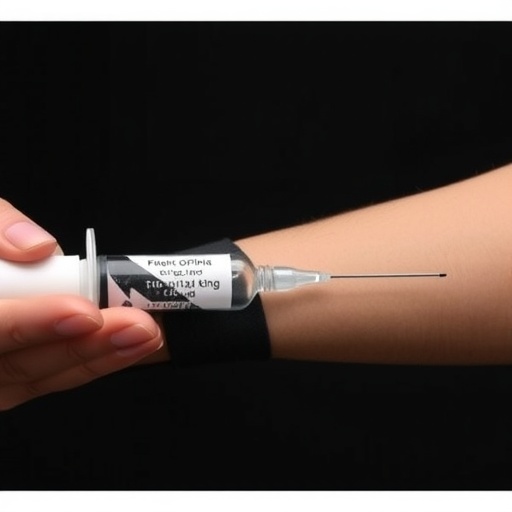
In recent years, the landscape of opioid prescribing has undergone significant scrutiny and transformation, particularly within the hospital setting. The emergence of alternative routes for opioid administration, such as transitioning from intravenous to subcutaneous methods, presents a critical juncture in improving patient care while addressing the pressing concerns of opioid safety and efficacy. A landmark study by Wu, B.J., Spear, R., and Doyle, M. et al., introduces a compelling examination of this transition, shedding light on its implications for hospitalized medical patients.
This groundbreaking research focuses on intravenous (IV) to subcutaneous (SC) opioid prescribing practices among hospitalized patients, providing essential insights into the effectiveness, safety, and overall patient outcomes associated with this shift. The implications of these findings are far-reaching and may redefine how opioids are administered in clinical settings, ultimately guiding future prescribing practices that prioritize patient wellbeing.
One of the pivotal motivations for exploring subcutaneous administration lies in addressing the challenges associated with IV opioid delivery. Traditional intravenous methods, while effective, come with a host of complications, including the risk of infections, the need for skilled personnel for IV placement, and significant discomfort for patients. By exploring subcutaneous routes, the study highlights a potentially safer and more patient-friendly alternative that could enhance the overall patient experience and satisfaction during hospital stays.
The research delves into the pharmacokinetics of subcutaneous opioid delivery, analyzing factors such as absorption rates, bioavailability, and the duration of analgesic effects. This technical examination reveals that subcutaneous administration can achieve comparable pain relief to intravenous methods while reducing the inherent risks associated with IV lines. Such revelations are crucial in the ongoing quest to improve pain management protocols without exacerbating the opioid crisis that has faced healthcare systems across the globe.
Moreover, the study meticulously compares dosage requirements and titration protocols between the two methods of administration. By providing data-driven insights into opioid dosing adjustments during the transition, Wu et al. present a roadmap for healthcare providers to navigate the complexities of opioid management in a hospital setting. This is particularly relevant in light of the variability in individual patient responses to opioids, underscoring the need for personalized medicine approaches in pain management.
Patient safety remains a prominent concern in opioid prescribing, especially amidst heightened awareness of addiction and overdose risks. The research findings underscore the importance of clinical monitoring and assessment when implementing subcutaneous opioids. Through rigorous evaluation of patient reactions and side effects, healthcare providers can better tailor opioid therapies to minimize risks while optimizing pain control.
In addition to patient safety, the study addresses the economic implications of transitioning to subcutaneous opioid prescribing. By analyzing healthcare costs associated with IV versus SC administration, the authors argue that transitioning to subcutaneous methods may not only enhance patient outcomes but could also result in cost savings for healthcare institutions. Fewer complications, reduced length of hospital stays, and increased efficiency in pain management could collectively contribute to more sustainable hospital operations.
Wu et al. also emphasize the need for comprehensive training and education for healthcare staff to facilitate this transition effectively. The research advocates for the development of protocols and guidelines that streamline subcutaneous opioid prescribing, ensuring that all members of the healthcare team are equipped with the knowledge necessary to implement these practices safely and competently. Such educational initiatives are vital not only for improving patient care but also for advancing the skillsets of healthcare professionals in an evolving medical landscape.
The potential for successful patient outcomes from subcutaneous opioid administration extends beyond individual cases. The study posits that widespread adoption of this practice could lead to a shift in institutional culture surrounding opioid prescribing. By prioritizing safety, patient preferences, and innovative methods of medication delivery, hospitals can take significant strides towards fostering an environment where patients feel empowered and engaged in their own care.
In conclusion, the research conducted by Wu, B.J., Spear, R., and Doyle, M. et al. marks a significant step forward in the ongoing discourse surrounding opioid prescribing practices in hospital settings. The transition from intravenous to subcutaneous opioid administration holds promise for enhancing patient safety, improving pain management, and addressing the broader challenges associated with opioid use. As hospitals and healthcare practitioners strive to adopt evidence-based practices, studies like this provide a critical foundation for shaping the future of opioid therapy.
The lessons learned from this research have the potential to resonate throughout the entire healthcare system, eventually influencing guidelines, training programs, and policies surrounding opioid prescribing. In a time when the medical community is actively seeking solutions to the opioid crisis, Wu et al.’s findings may very well contribute to a more compassionate and effective approach to pain management in hospitalized patients.
The journey toward incorporating subcutaneous opioid prescribing in healthcare settings is undoubtedly complex, yet it is one that is urgently needed. By drawing attention to the efficacy and safety of alternative routes of administration, this study encourages healthcare practitioners to engage thoughtfully with emerging evidence and adapt their practices in response to the evolving needs of patients.
Through ongoing research, advocacy, and collaboration, the medical community can work together to redefine the standards of opioid prescribing, ultimately paving the way for improved patient care and outcomes in the face of a challenging healthcare environment.
Subject of Research: Opioid prescribing practices in hospitalized medicine patients
Article Title: Intravenous to Subcutaneous Opioid Prescribing in Hospitalized Medicine Patients
Article References:
Wu, B.J., Spear, R., Doyle, M. et al. Intravenous to Subcutaneous Opioid Prescribing in Hospitalized Medicine Patients.
J GEN INTERN MED (2025). https://doi.org/10.1007/s11606-025-09834-7
Image Credits: AI Generated
DOI: 10.1007/s11606-025-09834-7
Keywords: opioid prescribing, subcutaneous administration, intravenous drugs, patient safety, pain management, healthcare costs, medical protocols, opioid crisis, personalized medicine, training and education.
Tags: clinical implications of opioid prescribingcomplications of intravenous opioidseffectiveness of subcutaneous opioidshospitalized patient careIV to SC opioid transitionopioid administration alternativesopioid delivery methodsopioid prescribing practicesopioid safety and efficacypatient outcomes in opioid therapypatient safety in opioid administrationsubcutaneous opioid therapy




